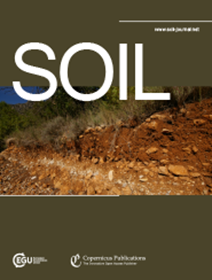巴西南部农业梯田免耕影响的土壤健康评估方法
IF 4.3
2区 农林科学
Q1 SOIL SCIENCE
引用次数: 0
摘要
摘要。土壤健康评价取决于适当选择指标和可靠、灵敏的测定方法。在这项研究中,评估了四种综合方法,以评估有无梯田免耕对巴西南部土壤健康的影响。采用的方法有:(1)主成分分析(PCA);(二)专家意见;(2) FERTBIO;土壤管理评价框架(SMAF)。所有办法都遵循四个步骤:(i)选择指标;对指标的解释;综合指标;(四)土壤健康指数计算。方法在指标选择、解释、指标整合等步骤上各不相同。使用的指标包括物理指标(容重、总孔隙度、土壤渗透阻力和保水能力)、化学指标(pH、钙、磷、钾、有机质、CEC和碱饱和度)和生物指标(微生物生物量碳、β-葡萄糖苷酶和芳基硫酸盐酶)。对玉米(2019/20和2021/22收成)、小麦(2021收成)和大豆(2020/21收成)的作物产量进行了评估。采用描述性统计、中位数比较、主成分分析和spearman相关分析对结果进行分析。结果表明,只有EO和FERTBIO方法能够灵敏地检测出不同管理制度下土壤健康状况的差异,说明免耕梯田土壤健康状况较好。生物指标在鉴别处理中较为敏感,在短期内反应迅速。免耕梯田处理下玉米(2019/20收获)和小麦(2021收获)产量较高。随着时间的推移,产量与土壤健康表现出更强的关系。研究结果强调了选择适当的土壤健康评价指标的重要性,并强调了农业梯田对生产系统可持续性的好处。本文章由计算机程序翻译,如有差异,请以英文原文为准。
Soil health approaches to assess the impacts of no-tillage with agricultural terraces in southern Brazil
Abstract. Soil health assessment depends on the appropriate selection of indicators and robust, sensitive methods for its determination. In this study, four integrative approaches were evaluated to assess the impacts of no-till with and without agricultural terraces on soil health in Southern Brazil. The different methods used were: (1) Principal Component Analysis (PCA); (2) expert opinion (EO); (2) FERTBIO; and (4) Soil Management Assessment Framework (SMAF). All approaches followed four steps: (i) selection of indicators; (ii) interpretation of indicators; (iii) integration of indicators; and (iv) calculation of soil health indices. The methods varied in the steps of indicator selection, interpretation, and the method of indicator integration. The indicators used included physical (bulk density, total porosity, soil penetration resistance, and water retention capacity), chemical (pH, calcium, phosphorus, potassium, organic matter, CEC, and base saturation), and biological indicators (microbial biomass carbon, β-glucosidase, and arylsulfatase). Crop yield was evaluated for maize (2019/20 and 2021/22 harvests), wheat (2021 harvest), and soybean (2020/21 harvest). Descriptive statistics, median comparisons, principal component analysis and spearman correlation analysis were applied for the analysis of results. The results showed that only the EO and FERTBIO approaches were sensitive enough to detect differences in soil health between management systems, indicating that no-till with terraces had better soil health. Biological indicators were more sensitive in differentiating treatments, showing a rapid response in the short term. Maize (2019/20 harvest) and wheat (2021 harvest) yields were higher under the no-till with terraces treatment. Over time, yield showed a stronger relationship with soil health. The results highlight the importance of selecting appropriate indicators for soil health assessment and reinforce the benefits of agricultural terracing for the sustainability of production systems.
求助全文
通过发布文献求助,成功后即可免费获取论文全文。
去求助
来源期刊

Soil
Agricultural and Biological Sciences-Soil Science
CiteScore
10.80
自引率
2.90%
发文量
44
审稿时长
30 weeks
期刊介绍:
SOIL is an international scientific journal dedicated to the publication and discussion of high-quality research in the field of soil system sciences.
SOIL is at the interface between the atmosphere, lithosphere, hydrosphere, and biosphere. SOIL publishes scientific research that contributes to understanding the soil system and its interaction with humans and the entire Earth system. The scope of the journal includes all topics that fall within the study of soil science as a discipline, with an emphasis on studies that integrate soil science with other sciences (hydrology, agronomy, socio-economics, health sciences, atmospheric sciences, etc.).
 求助内容:
求助内容: 应助结果提醒方式:
应助结果提醒方式:


